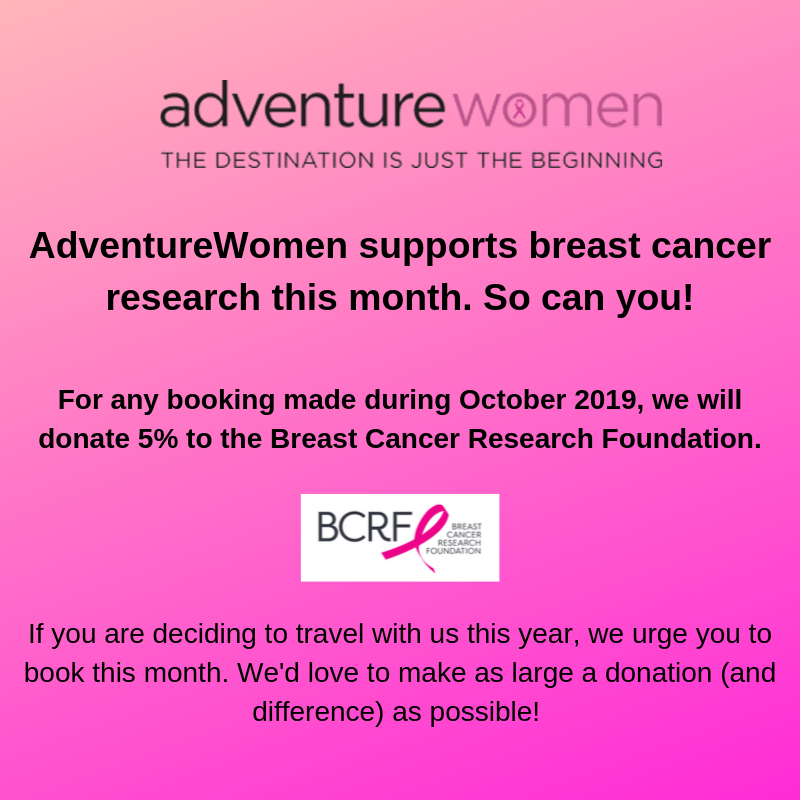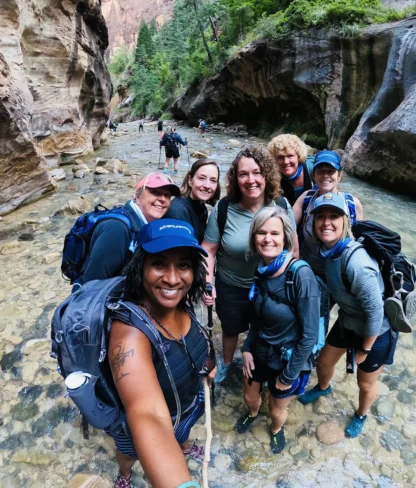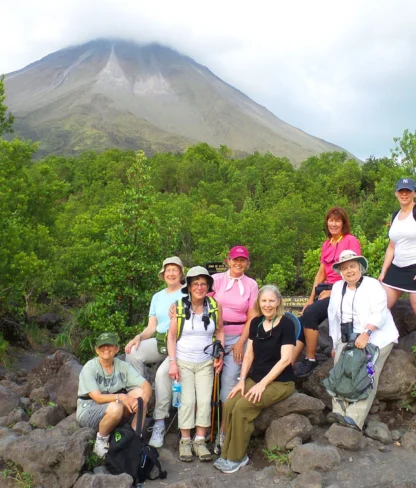Why AdventureWomen Supports Funding for Breast Cancer Research

Join us, AdventureWomen, as we continue to honor October as Breast Cancer Awareness Month. We will donate 5% of all bookings made in October 2019 to the Breast Cancer Research Fund.

Each of us has been touched by this prolific disease, either directly or within our own close universe of family and friends. Many of our AdventureWomen travelers know it intimately, and bravely. It has both humbled and strengthened us, providing a unifying cause on behalf of the women we know and love across our country, and around the world.

With thanks to relentless women’s advocacy (let’s just call that a collective superpower), public education, and media attention, many more women today are familiar with the cold hard (and still hard-to-fathom) statistics around of breast cancer:
- Every 2 minutes a woman is diagnosed with breast cancer in the U.S.
- Breast cancer is the second leading cause of death (after lung cancer) in women.
- About 1 in 8 women in the U.S. (12%) will develop breast cancer in her lifetime.
- About 269,000 new cases of invasive breast cancer and 63,000 of non-invasive breast cancer will be diagnosed in U.S. women in 2019.
- This year, an estimated 41,760 U.S. women will likely die from breast cancer.
- Black women are 42% more likely to die of breast cancer than white or Hispanic women.
- About 85% of breast cancers occur in women with no family history.
SILVER LININGS IN THE FIGHT AGAINST BREAST CANCER
Silver linings in the fight against breast cancer are starting to appear—and more frequently than ever before. Thanks to the vigorous pursuit of cancer research, the hopeful statistics below reflect undeniable progress in diagnosis and treatment for breast cancer:
- For 30 consistent years now, the breast cancer death rate continues to decline. To put that in numbers we can cheer about: 376,000+ cancer deaths have been averted since 1990. This is attributed to awareness and improvements in early detection and new treatments.
- The 5-year breast cancer survival rate is now at an all-time high of 99%—due to early diagnosis at a localized stage.
- There are currently more than 3.5 million breast cancer survivors in the United States.

OUT-OF-THE-BOX RESEARCH BRINGS REMARKABLE RESULTS
In 2018-2019, numerous grants and international awards were given to tireless, behind-the-scenes scientists to both support and celebrate a huge range of innovative research in the study of breast cancer. Armed with a big-picture understanding of the nature of this disease, oncologists and cancer research teams are better equipped than ever to target complex minute details—those critically important puzzle-pieces—that lead to life-extending and, ultimately, life-saving therapies for women with breast cancer.
Here are 4 exciting recent discoveries and promising treatments in the search for a cure for breast cancer:
- Tomosynthesis Mammography – This advanced, 3D diagnostic mammography screening tool is fast replacing traditional radiology with more precise cancer detection and fewer false alarms. (Ask if your radiology lab offers this option; if not, you can request that your doctor send you to one that does).
- Herceptin Upgrade – The drug Herceptin (trastuzumab), used since 1998, has been effective in treating both early and invasive HER2 breast cancers. Now, a new FDA-approved formulation—Herceptin Hylecta—combines the original drug with the enzyme hyaluronidase. Together, this powerhouse duo can target the HER2 breast cancer cells and block them from receiving growth signals, and therefore spreading.
- BRCA Gene Test – Angelina Jolie brought this test to the attention of the world in 2013 when she chose to learn whether she had the cancer-causing family gene mutation (BRCA1 and BRCA2)—which puts family members at high risk for developing the disease. The good news is that the former government regulations on personal genes have been banned. This means that now all women with a history of family breast cancer who choose to have this once prohibitively expensive test, can… And it’s now covered by most major health insurers.
- Genomic Tests – Not to be confused with genetic testing (which uses blood or saliva samples), the newest genomic tests are performed directly on early-stage breast tumor samples. They can reveal the likelihood of the cancer genes to spread and grow, or even if they will return after surgery. Armed with this information, women and their doctors can now make the informed decision of whether to proceed with chemotherapy, or safely determine it isn’t necessary. The most common genomic test used today is MammaPrint (many national health insurers cover the test).

ALWAYS MORE TO LEARN WHEN IT COMES TO BREAST CANCER
And finally… In the spirit of “information is power,” we’d like to share a few sources of valuable information that showcase the latest breast cancer statistics, state-of-the-art research, the best places for breast cancer care, and some of the best 2019 breast cancer blogs:
- American Cancer Society: One of the web’s most comprehensive sites covers the disease from diagnosis and treatment to living life as a breast cancer survivor and offers the latest information on current research.
- Cure: A compilation of news, research updates, personal stories, and videos about cancer.
- Healthline Newsletter: A list of the 2019 best breast cancer blogs.
- Women’s Choice Awards 2019: Best Breast Centers in America. A list of breast cancer patient-recommended facilities across the country that meet a stringent criteria list of care, from radiology and treatment to rehabilitation and support.
GET YOUR MAMMOGRAM
Just a reminder…
The American Cancer Society recommends annual screenings from age 45, with the option for women to be screened when they turn 40, if they prefer. The differences reflect changing opinions on what age the benefits of screening outweigh the risks.
“Hope and fear cannot occupy the same space at the same time.” – Maya Angelou


